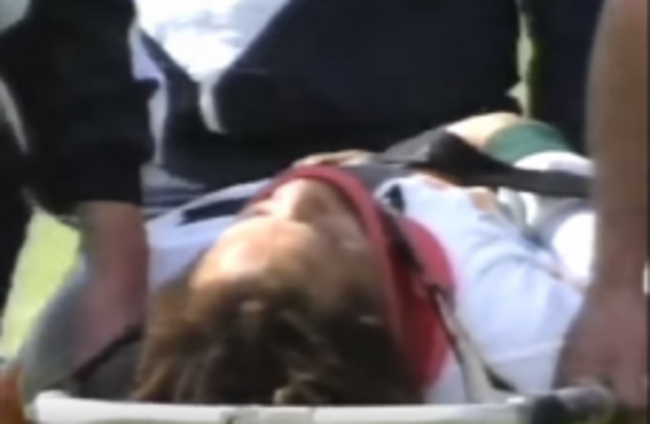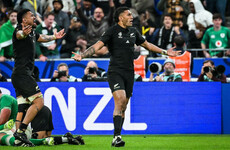THE 1995 RUGBY World Cup was memorable for so many reasons. While there was the euphoria and symbolic power of South Africa’s defeat of New Zealand in the final in what was the first major post-apartheid sporting event that the former country had hosted, this celebration of all that was good about the game was also tinged with sadness.
While the tournament was filled with stars such as Jonah Lomu, Michael Lynagh and Will Carling, there were also countless obscure players with the so-called lesser countries that even hardcore fans of the game were unlikely to have heard of.
Max Brito was one of the less well-known participants to feature in the competition, appearing for Ivory Coast, the only other African team competing that year aside from the eventual winners.
The 1995 Rugby World Cup is regarded by many as the symbolic beginning of the professional era in rugby, but regardless, no player involved at the time was earning the kind of lucrative wages that many modern stars enjoy.
Brito was no exception — in addition to playing for Biscarrosse Olympique in the Fédérale 3 division of French rugby, he worked as an electrician.
Not many people expected Ivory Coast to have much of an impact on the competition given their lack of a rugby-playing tradition compared with other sides, and so it proved. They lost their opening two games — 89-0 to Scotland and 54-18 to France respectively — exiting the tournament at the earliest possible stage as a result.
Going into the third match, on 3 June 1995, Tonga had also been beaten twice, rendering the game a dead rubber, with both teams no longer having a chance of progression to the knockout stages. Brito was making just his third appearance for Ivory Coast at test level, and his second start in the competition, having featured in the first XV against France and as a substitute in the opening loss to Scotland.
After just three minutes of this encounter, however, an incident occurred that would overshadow everything that followed. Brito, playing on the wing, caught hold of a high ball. He ventured forward before being tackled by Tongan flanker Inoke Afeaki. As the play continued, a ruck formed over Brito and subsequently collapsed as he lay prone on the ground, with several players falling on top of the Ivorian as a result.
The seriousness of the injury that resulted was soon apparent. Brito was motionless on the ground for a sustained period as he awaited medical attention before being carried off on a stretcher.
The 24-year-old had suffered a broken vertebrae and was swiftly brought to the intensive care unit of the Unitas Hospital in Pretoria. Yet despite operations undertaken in an attempt to stabilise the fourth and fifth vertebrae, the incident ultimately left Brito paralysed below the neck.
Brito was given compensation following the accident, with every team who participated in the tournament contributing to the cause. Nonetheless, the scale of what has been described as ‘the greatest tragedy in World Cup history’ only grew thereafter. Ever since the incident, Brito has largely been bedridden and confined to a wheelchair.
A 2007 interview with Le Monde portrayed an individual deep in despair 12 years on from the accident, or “my curse” as he referred to it
“I have come to the end of my tether,” he is quoted as saying. “If one day I fall seriously ill, and if I have the strength and courage to take my own life, then I will do it.”
The ex-player, even after 12 years, could only move his head, upper body and one arm. His wife had left him, while his teenage sons, he claimed, only visited him “to take money off me so they can go out and buy things”.
Warning: The following video contains images that some viewers may find upsetting.
A year after the accident, Harvey Thorneycroft, a Northampton winger, led a tour to raise funds for Brito, with other notable names including Martin Johnson and Graham Rowntree taking part. The Professional Rugby Players’ Association also tried to help the Ivorian, but ex-England sevens player Damien Hopley, who also had to retire early because of injury, highlighted the lack of support for Brito in the long term.
In additon, with rugby stars increasingly becoming bigger, faster and more aggressive than ever in the modern age, concerns have been expressed that a repeat of the Brito incident could occur in the near future. Although the injury that the Ivorian suffered was extremely rare, there is perceived to be a greater risk of such issues occurring at competitions like the World Cup, with minnows featuring amateurs coming up against much stronger professional teams.
Furthermore, in 2003, the Independent on Sunday quoted English Rugby Football Union chief medical officer Dr Simon Kemp saying that injuries such as Brito’s statistically “shouldn’t occur more than once in every four World Cups”.
Ivory Coast, meanwhile, have not featured in a Rugby World Cup since 1995, while Brito’s grim fate prompted plenty of debate on whether it was appropriate to allow inexperienced nations to compete with the heavyweights of the game in such pressurised circumstances.
And now, after more than two decades have passed since one of rugby’s most infamous incidents, Brito reportedly continues to live as a quadriplegic in Bordeaux. He retains some income from the Rugby World Cup insurance, while officials still offer invitations to subsequent tournaments, but the former player lives primarily off social welfare these days.
Yet, although not exactly a redemption, there has been at least a hint of positivity in recent times. Notwithstanding the immense trauma he has suffered at its hands, the latest reports indicate that Brito continues to reserve an unlikely, unflagging passion for the sport of rugby.
The Times reports that back in May, an ex-Ivory Coast teammate Djakaria Sanoko — who still visits Brito sporadically at his home — organised his first visit to the Ivory Coast in almost two decades.
A benefit game was arranged with over 60 players — many of whom were ex-teammates of Brito — taking part. More encouragingly still, at 44, Brito has a new partner who cares for him on a daily basis, while in stark contrast with 2007, he holds an increasingly hopeful outlook on life, telling reporters last May:
“I have managed to vanquish my handicap. When you accept what has happened, you can move on. When you refuse to accept it, you can never find a way through. My aim today is to relaunch rugby [in Ivory Coast] by training young players.”
Despite this positive note, however, Brito’s story remains essentially tragic. With the 2015 competition set to begin, the 1995 accident continues to serve as a timely reminder of the considerable risk involved and courage that rugby players at a high level require to continually put their bodies on the line, particularly during high-profile events such as the World Cup, where media hype and intensity levels on the pitch go into overdrive.
Brito’s sad tale ultimately gives a glimpse into the dark side of the sport, with most people preferring to associate 1995 with the image of a smiling Nelson Mandela in the Springboks jersey, rather than the haunting footage of a young Ivorian man laying prone on the ground for far too long. Just like the former event however, the latter one should not and cannot afford to be forgotten by anyone who loves and cares about the game.











Good to see Eamon Dunphy was spot on with his assessment of Brazil during his rant at the end of the champions league final…
Piques trips don’t lie….
And then Neymar does that!!!
outrageous. great goal.Barca will be happy. the Luiz clearance was a massive turning point
game was well over when luiz cleared
Brazil are still a class team. I think they will go on and win the World Cup for a sixth time.
Not a hope, they are only good in all those “nobody cares” cups or world tours.
Titles or cups meant nothing tonight. That was a simple case of passion and “who’s the best”. What a game! Fook the begrudgers”
Some clearance from Luiz that was more impressive than Neymars goal
Trappatoni has to go!
This is Spain’s Bishop Brennan’s kick up the arse. They’ll be back.
Def not joe, Brazil seem to really want it. But great clearance by David Luiz, coulda been a draw.
After the passionate singing of the national anthem there was always only going to be one winner. Brazil were awesome at times. Great curtain raiser for WC 2014.
I hope now people stop saying Neymar is the most overrated player ever.
first time since 1985 spain lose 3-0
Shakira played a great game.
Richie sadlier sounds like gift grubs Shane lunch :D
scrappy goal.arbeloa having a nightmare. have money on Spain. not looking good at the moment
Tippy tappy taps out!
After watching that masterpiece by Brazil tonight do you all, well almost all, still think as you did last year here on thejournal.ie, the Euro is of a much higher standard than The World Cup? :) :) :)
Brazil were class tonight! David Luiz was like a man possesed! Can’t wait to see Neymar playing with Barca! The only thing I’ll say is Spain played 120 minutes against Italy,had a days less rest & that pitch wasn’t fixed up since the last match.
Best game any of you will ever see!!
That would be France v Germany in the 1982 World Cup. I haven’t googled anything, so I may have something slightly wrong.
Did you watch it at the tennis club Paul?
I didn’t see the match, just saw the goals. I did see Brazil’s games against Italy and another team and was unimpressed with the standard of football. I know football and politics are two completely different things but at a time when there is so much trouble, pain and anger in the country, a lot of which is centred around the costs of holding a world cup and having terrible health care, high taxes, poor education etc, I would have felt sorry for brazil if they lost the game because the country needs a lift and something to cheer about and there were a lot of sacrifices made for it. I was surprised to see the score of 3-0 and I wonder if Spain weren’t giving it 100 per cent for these reasons above. As I said I didn’t see the game so I’m not saying they didn’t deserve to win, I just wonder if the result would have been different if it was the world cup final at stake.
Here’s where your analysis fell down – “I didn’t see the match”. Spain looked tired and Brazil broke them. They could have won by 5
Haha fair enough
Just figured out why good comments get red thumbs including trolls……..!!
I always knew that my team would get back on track ;) also I think that they needed some time to reconnect again with the new players